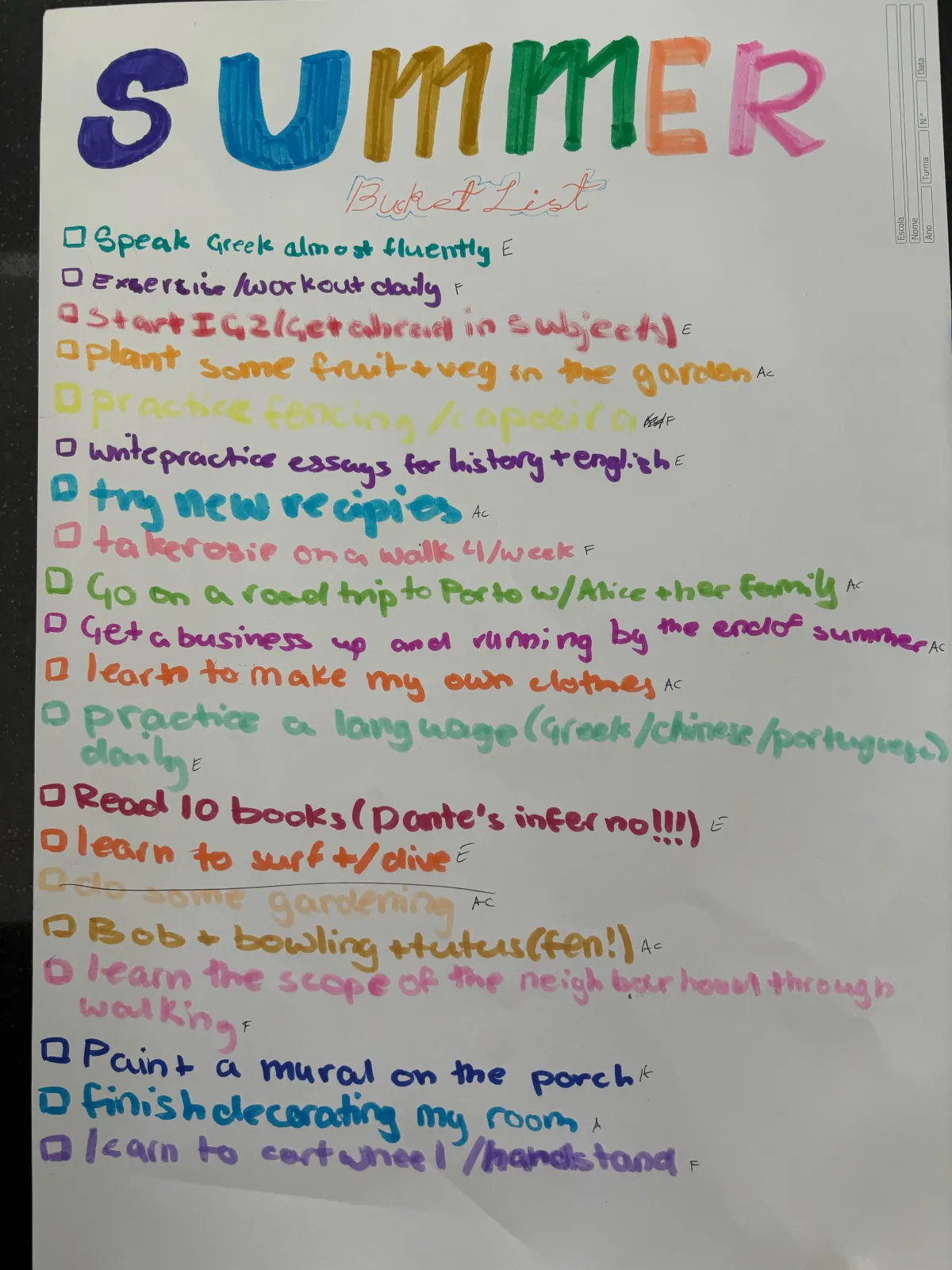JULY 21, 2025
The Day My Kid Handed Me a 20-Activity Summer Schedule (And I Recognized Our Original Startup Planning)
Another installment of our "Build in Public" series. Today: learning resource allocation from someone who thinks she can master Greek, start a business, and read The Divine Comedy by Dante Alighieri before Labor Day.
Last month, I was having breakfast while checking my inbox when my daughter slides a cardboard across the kitchen table. "Here's my summer bucket list, Dad."
I glance down expecting the usual kid stuff: pool time, ice cream, maybe a camping trip.
Instead, I see 20 meticulously planned color-coded activities:
"Speak Greek almost fluently"
"Get a business up and running by the end of summer"
"Learn to make my own clothes"
"Read 10 books (Dante's Inferno!!!)"
"Learn to surf and/or dive"
And that's just the five of the items... The juxtaposition alone makes me proud to be her father.

The Moment of Recognition
As I scan her rainbow-colored masterpiece, something uncomfortably familiar hits me. This isn't just an ambitious kid's summer plan. This is exactly how we initially approached our product roadmap.
The same beautiful, impossible optimism. The same refusal to acknowledge resource constraints. The same belief that if you plan it with enough enthusiasm and color-coding, the laws of time and physics will bend to accommodate your vision.
She's essentially created a startup project management problem, but with felt tip pens.
The Math That Actually Matters
Here's what my daughter's schedule really looks like:
She doesn't want to do 20 activities across 8 weeks. She wants to do most of them simultaneously. Daily language practice, daily exercise, daily dog walks, plus weekly business development, plus learning surfing, fencing and capoeira, mastering mural painting, getting ahead in next school year’s subjects...
It's not 20 ÷ 8 weeks. It's more like 10 daily commitments + 10 weekly projects + 10 aspirational goals that somehow need to fit into the same 24-hour days that adults struggle to fill with basic responsibilities.
Sounds familiar, fellow founders?
The Beautiful Delusion We Share
Looking at her plan, I realize my daughter and I suffer from the same cognitive bias that plagues every startup I know: the planning fallacy with a side of magical thinking.
In startup terms, she's essentially saying: "I'll achieve product-market fit, scale to 10k users, close Series A, and build enterprise features... all while maintaining perfect code quality and work-life balance."
Her summer schedule reads like one of our first planning sessions:
Overestimate available time ✓
Underestimate complexity ✓
Assume perfect execution ✓
Ignore competing priorities ✓
Plan like motivation is infinite ✓
The difference? She's 13 years old, so this kind of optimism is adorable. When I do it, developers question my judgment.
What Her Planning Reveals About Mine
Watching her confidently schedule "start IG2 (get ahead in subjects)" right before "plant some fruit + veg in the garden" made me reflect on our original GYST roadmap.
Why did we add "build user onboarding" to a sprint that already included "implement AI-powered revenue optimization"? Why did we treat complex product features like they're equivalent to quick bug fixes?
Her schedule assumes that learning to surf or dive requires the same time investment as "try new recipes." Our original product plan made similar category errors, treating integration work like it's as simple as copy changes.
The Psychology of Impossible Plans
What fascinates me isn't that she made an impossible plan; it's that she made it with such confidence. Zero self-doubt. Zero resource anxiety. Zero consideration of trade-offs.
There's something beautiful about this kind of fearless planning. She's not limited by experience telling her what's "realistic." She hasn't internalized the constraints that make adults hedge their ambitions.
But there's also something terrifying about it. Because I recognize this exact mindset in every failed startup plan I've seen, including my own.
The same optimism that lets her casually add "paint a mural on the porch" to an already packed schedule is what makes founders promise investors they'll achieve hockey stick growth while simultaneously perfecting their product, scaling their team, and expanding to three new markets.
The Creator Economy Connection
Here's what really gets me: scattered among the surf lessons and room decoration, she's casually included "get a business up and running by the end of summer."
To her, starting a business is just another summer activity. Like learning to dive or reading Dante. It sits comfortably between “try new recipes” and "learn to make my own clothes" with no sense that this might be categorically different.
This is the generation we're building GYST for. They don't see business creation as this massive, scary leap that requires extensive planning and risk management. They see it as a skill to pick up over summer break.
Which raises the question: are we overcomplicating entrepreneurship, or is she underestimating it?
What I'm Watching For
Over the next eight weeks, I'm curious to observe which activities survive first contact with reality. My predictions:
First to go: The daily commitments that require sustained discipline (sorry, Greek)
Most likely to stick: The creative projects with immediate gratification (murals, recipes)
Wild card: The business goal because entrepreneurship might actually suit her scattered, opportunistic energy
I'm also watching my own planning behavior. Her fearless schedule is making me question whether our GYST roadmap is too conservative or too aggressive. Are we thinking too small because we've learned to hedge our bets? Or are we falling into the same magical thinking trap, just with more sophisticated vocabulary?
The Startup Lesson Hidden in Felt Tip Pens
There's something startup founders can learn from watching a 13-year-old plan her impossible summer:
The power of not knowing what's impossible. Her plan would get laughed out of any reasonable adult planning session. But some of the best startup ideas started with similar "unrealistic" ambitions.
The danger of planning without constraints. Her schedule assumes unlimited time, energy, and attention. Startup plans often make similar assumptions about market conditions, team capacity, and user adoption.
The value of optimistic vision, even when execution falls short. Even if she accomplishes 20% of her list, she'll have an incredible summer. Maybe ambitious startup planning works the same way.
The Watching Game
As I write this, it's July 2nd. She's already practicing Greek phrases while planning her first business idea (something involving friendship bracelets and "global distribution").
I'm not going to tell her the math doesn't work. I'm not going to explain resource allocation or time management or opportunity cost.
Instead, I'm going to watch and learn. Because maybe the problem isn't that kids and founders make impossible plans. Maybe the problem is that most of us learn to stop making them.
The magic happens in the gap between ambition and reality. Sometimes you discover you can actually learn enough Greek to impress your friends. Sometimes you find product-market fit faster than your conservative projections suggested.
And sometimes you learn that the real skill isn't making perfect plans; it's staying excited about the impossible ones long enough to discover what's actually possible.
I'll report back in September on what survived the summer collision between dreams and reality. For both her bucket list and our startup roadmap.
© Copyright 2025. GYST. All rights reserved. Privacy Policy. Terms of Service.

